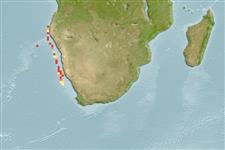>
Scombriformes (Mackerels) >
Gempylidae (Snake mackerels)
Etymology: Paradiplospinus: Greek, para = the side of + Greek, diploos = double + Latin, spina, pinna = thron (Ref. 45335).
Environment: milieu / climate zone / depth range / distribution range
Écologie
marin bathydémersal; profondeur 368 - 626 m (Ref. 6181). Deep-water; 16°S - 30°S, 3°E - 15°E (Ref. 6181)
Southeast Atlantic: known only from off Namibia and western South Africa.
Taille / Poids / Âge
Maturity: Lm ? range ? - ? cm
Max length : 52.0 cm SL mâle / non sexé; (Ref. 27121)
Épines dorsales (Total): 35 - 38; Rayons mous dorsaux (Total): 26-30; Épines anales 2; Rayons mous anaux: 24 - 29; Vertèbres: 60 - 64. Body is extremely elongate. Mouth is large and with fang-like teeth. Eyes large. Pyloric caeca 6. Color of body and fins brownish black.
Occurs in the upper continental slope (Ref. 6181). Juveniles probably pelagic (probably mesopelagic) (Ref. 6181). Specimens 35 to 40 cm SL had ripe gonads (Ref. 6181).
Life cycle and mating behavior
Maturité | Reproduction | Frai | Œufs | Fécondité | Larves
Nakamura, I. and N.V. Parin, 1993. FAO Species Catalogue. Vol. 15. Snake mackerels and cutlassfishes of the world (families Gempylidae and Trichiuridae). An annotated and illustrated catalogue of the snake mackerels, snoeks, escolars, gemfishes, sackfishes, domine, oilfish, cutlassfishes,. scabbardfishes, hairtails, and frostfishes known to date. FAO Fish. Synop. 125(15):136 p. (Ref. 6181)
Statut dans la liste rouge de l'IUCN (Ref. 130435)
Menace pour l'homme
Harmless
Utilisations par l'homme
Plus d'informations
RéférencesAquacultureProfil d'aquacultureSouchesGénétiqueElectrophoresesHéritabilitéPathologiesTraitementNutrientsMass conversion
CollaborateursImagesStamps, Coins Misc.SonsCiguateraVitesseType de nageSurface branchialeOtolithesCerveauxVision
Outils
Articles particuliers
Télécharger en XML
Sources Internet
Estimates based on models
Preferred temperature (Ref.
123201): 6.2 - 7.9, mean 7 °C (based on 8 cells).
Phylogenetic diversity index (Ref.
82804): PD
50 = 0.7500 [Uniqueness, from 0.5 = low to 2.0 = high].
Bayesian length-weight: a=0.00102 (0.00046 - 0.00225), b=3.06 (2.88 - 3.24), in cm total length, based on all LWR estimates for this body shape (Ref.
93245).
Niveau trophique (Ref.
69278): 4.5 ±0.7 se; based on diet studies.
Résilience (Ref.
120179): Milieu, temps minimum de doublement de population : 1,4 à 4,4 années (Preliminary K or Fecundity.).
Fishing Vulnerability (Ref.
59153): Moderate to high vulnerability (45 of 100).
Climate Vulnerability (Ref.
125649): High to very high vulnerability (66 of 100).
Nutrients (Ref.
124155): Calcium = 28.5 [13.6, 68.3] mg/100g; Iron = 0.46 [0.18, 1.05] mg/100g; Protein = 17.2 [15.0, 19.1] %; Omega3 = 0.275 [0.144, 0.534] g/100g; Selenium = 19.2 [8.0, 42.4] μg/100g; VitaminA = 14.6 [3.1, 68.0] μg/100g; Zinc = 0.308 [0.206, 0.462] mg/100g (wet weight);
